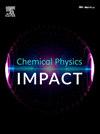CH3NH3Pb1−xcuxi3基太阳能电池:不同无机空穴传输层的数值研究与优化
IF 4.3
Q2 CHEMISTRY, PHYSICAL
引用次数: 0
摘要
掺杂吸收剂杂化钙钛矿为提高稳定性和降低毒性开辟了广阔的研究领域,这使太阳能电池更接近市场和商业化。本研究的目的是研究和改进一种太阳能电池,该电池由活性卤化铅钙钛矿层组成,其中Pb部分被Cu取代。这种替代以2%的比例发生。这项工作的第一步是通过将我们的计算结果与文献中报道的实验结果进行比较来验证我们的计算。比较了FTO/TiO 2 /钙钛矿/Spiro-OMeTAD/Au结构电池的电流密度-电压(J-V)特性、外量子效率(EQE)和光伏参数。仿真结果表明,Spiro-OMeTAD作为html时的功率转换效率(PCE)为11.8%,与实验结果相似。然后,研究了用CuSCN、Cu2O、CuI等几种HTL替代Spiro-OMeTAD的影响,以及吸收层的物理参数如缺陷密度(Nt)、厚度(d)、辐射复合系数(Brad)、掺杂浓度(NA和ND)、串联(Rs)、分流(Rsh)电阻等对器件性能的影响,以及工作温度的影响。仿真结果表明,Cu2O作为html具有最好的性能。结果表明,吸附层的最佳物理参数为Nt=1013 cm−3,d=1µm, Brad=10 ~ 16 cm3/s, NA=1020 cm−3,ND=109 cm−3,Rs=0 Ω。, Rsh=6000 Ω。cm2导致PCE为26.92%。本文章由计算机程序翻译,如有差异,请以英文原文为准。

CH3NH3Pb1−xCuxI3-based solar cell: Numerical study and optimization with different inorganic hole transport layers
Doping the absorber hybrid perovskite open a wide research area to improve stability and decreasing toxicity, this brings the solar cell closer to the market and commercialization. The objective of the present study is to examine and refine a solar cell comprising an active lead halide perovskite layer, in which Pb has been partially substituted with Cu. This substitution has occurred on a scale of 2 %. The first step of this work involved validating our calculations by comparing them with experimental results reported in the literature. This comparison included current density-voltage (J-V) characteristics, external quantum efficiency (EQE), and photovoltaic parameters of cells with the structure FTO/TiO₂/perovskite/Spiro-OMeTAD/Au. The simulations showed high similarity with experimental results when Spiro-OMeTAD is used as HTL, with a power conversion efficiency (PCE) of 11.8 %.Then, the influence of replacing Spiro-OMeTAD with several HTL such as CuSCN, Cu2O, and CuI, as well as the effect of physical parameters of the absorber layer such as the defect density (Nt), thickness (d), radiative recombination coefficient (Brad), doping concentration (NA and ND), series (Rs), and shunt (Rsh) resistance on the device performance was investigated, in addition to operating temperature effect. According to simulation results, Cu2O as the HTL provides the best performance. The optimal physical parameters for the absorbent layer were found to be Nt=1013 cm−3, d = 1 µm, Brad=10−16 cm3/s, NA=1020 cm−3, ND=109 cm−3, Rs=0 Ω.cm2, and Rsh=6000 Ω.cm2 resulting in a PCE of 26.92 %.
求助全文
通过发布文献求助,成功后即可免费获取论文全文。
去求助
来源期刊

Chemical Physics Impact
Materials Science-Materials Science (miscellaneous)
CiteScore
2.60
自引率
0.00%
发文量
65
审稿时长
46 days
 求助内容:
求助内容: 应助结果提醒方式:
应助结果提醒方式:


